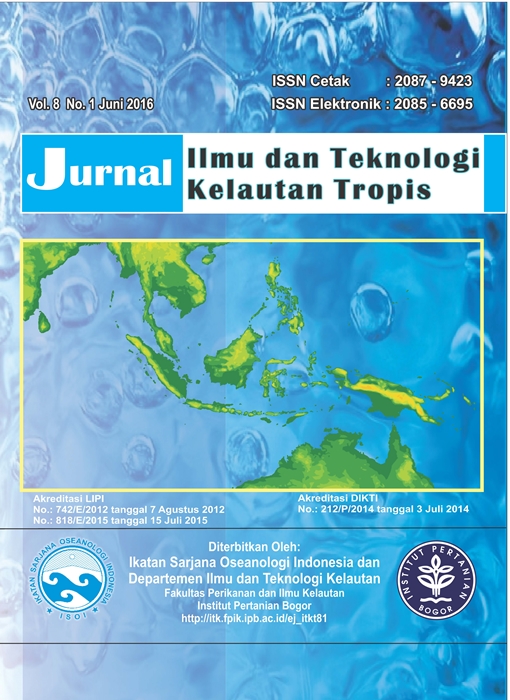MORPHOLOGICAL CHARACTER AND MOLECULAR IDENTIFICATION WITH COI GENE MARKER OF HORSESHOE CRABS (Tachypleus gigas) AT COASTAL WATERS OF NORTHERN JAVA ISLAND
Abstract
The existence of horseshoe crabs Tachypleus gigas is currently on the threatened condition and its population status is also unclear. The objectives of this research were to asses the horseshoe crabs morphological characters and to identify based on molecular marker of Cytochrome Oxydase Subunit I (COI) gene. The samples were collected from five locations (Segara Menyan Subang, Ujung Kulon Banten, Tambak Lorok Semarang, Betah Walang Demak, and Kenjeran Surabaya) in October 2014 until June 2015. A total of 27 parameters for 62 individuals were used to determine connectivity and character identifier among populations. Data were tested using non-parametric analysis. While, the 5 individuals from each sites were used for molecular analysis including several stages of the DNA extraction, DNA electrophoresis, amplification and visualization of DNA fragments, and DNA sequencing. The results obtained based on morphological characters that T. gigas of Surabaya formed a unique group due to its body size (X1-X2 and X4-X16) was larger than the other 5 body parts (X22, X23, X26-X28) of Semarang, Demak, Subang, and Banten. According to molecular results, there were 650 bp conserve nucleotide sequences. Analysis using software MEGA 5.0 showed that there were 73 existence of specific nucleotide sites that can be used to distinguishes between T. gigas in-groups and out-groups (T. gigas from Central Arabian Sea, T. tridentatus from Sweden, and Carcinoscorpius rotundicauda from USA).
Keywords: horseshoe crabs, Java coast, morphology, identification molecular, CO1 gene.
Authors
This work is licensed under a Creative Commons Attribution 4.0 International License.
Jurnal Ilmu dan Teknologi Kelautan Tropis i is an open-access journal, meaning that all content is freely available without charge to the user or their institution. Users are allowed to read, download, copy, distribute, print, search, or link to the full texts of the articles in this journal without needing to request prior permission from the publisher or the author.
All articles published by Jurnal Ilmu dan Teknologi Kelautan Tropis are licensed under the Creative Commons Attribution 4.0 International License. This allows for unrestricted use, distribution, and reproduction in any medium, provided proper credit is given to the original authors.
Authors submitting manuscripts should understand and agree that the copyright of published manuscripts is retained by the authors. Copyright encompasses the exclusive rights of authors to reproduce, distribute, and sell any part of the journal articles in all forms and media. Reproduction of any part of this journal, its storage in databases, and its transmission by any form or media is allowed without written permission from Jurnal Ilmu dan Teknologi Kelautan Tropis.


